Try this chicken with peanut butter for a quick, easy, and flavorful meal that’s perfect for any day.
Table of Contents
Why I love this recipe
The chicken with peanut butter -recipe holds a special place in my culinary repertoire because it masterfully balances simplicity and indulgence. This dish combines tender, succulent chicken with the creamy, nutty depth of peanut butter, creating a harmony of flavors that tantalizes the palate.
What sets this recipe apart is its ability to transform humble ingredients into something extraordinary. With every bite, you experience a delightful contrast of textures and tastes—richness from the peanut butter, the savory allure of the chicken, and a subtle hint of spice that elevates the dish. It’s versatile enough to suit a casual weeknight dinner yet sophisticated enough for a special occasion.
The chicken with peanut butter -recipe also celebrates adaptability. It welcomes a variety of accompaniments, from steamed jasmine rice to vibrant stir-fried vegetables, making it an excellent choice for customizing to your preferences. Its ease of preparation ensures you spend less time in the kitchen and more time enjoying the meal.
Ultimately, this dish embodies comfort and creativity, a testament to how global flavors can come together in a way that feels both familiar and adventurous. The chicken with peanut butter -recipe is a true culinary treasure that brings joy to every table.
Ingredients needed
Chicken breasts – Use boneless, skinless chicken breasts for this recipe, cut into bite-sized pieces to ensure even cooking and tenderness.
Creamy peanut butter – Opt for natural peanut butter with no added sugar or oil. Its rich, nutty flavor is the cornerstone of the chicken with peanut butte.
Soy sauce – Provides a savory, umami punch. Tamari or coconut aminos can be used as alternatives for a gluten-free option.
Garlic cloves – Minced fresh garlic adds depth and a robust aroma, essential for balancing the richness of the peanut butter.
Fresh ginger – Grated ginger gives the dish a warm, zesty kick and complements the other flavors beautifully.
Hoisin sauce – A slightly sweet and tangy ingredient that enhances the savory notes of the dish while adding a silky texture.
Rice vinegar – A splash of rice vinegar brings brightness and balance to the sauce.
Sesame oil – Just a drizzle of this fragrant oil imparts a nutty, toasty undertone to the dish.
Cornstarch – Used to thicken the sauce, ensuring it clings perfectly to every piece of chicken.
Red chili flakes – Optional, for a touch of heat that livens up the flavor profile.
Vegetable oil – Use a neutral oil like canola or peanut oil for stir-frying the chicken to golden perfection.
How to make peanut butter chicken
Step 1 – Prepare the chicken
In a bowl, coat bite-sized chicken pieces with cornstarch. This helps create a crispy exterior when cooked and allows the sauce to adhere better.
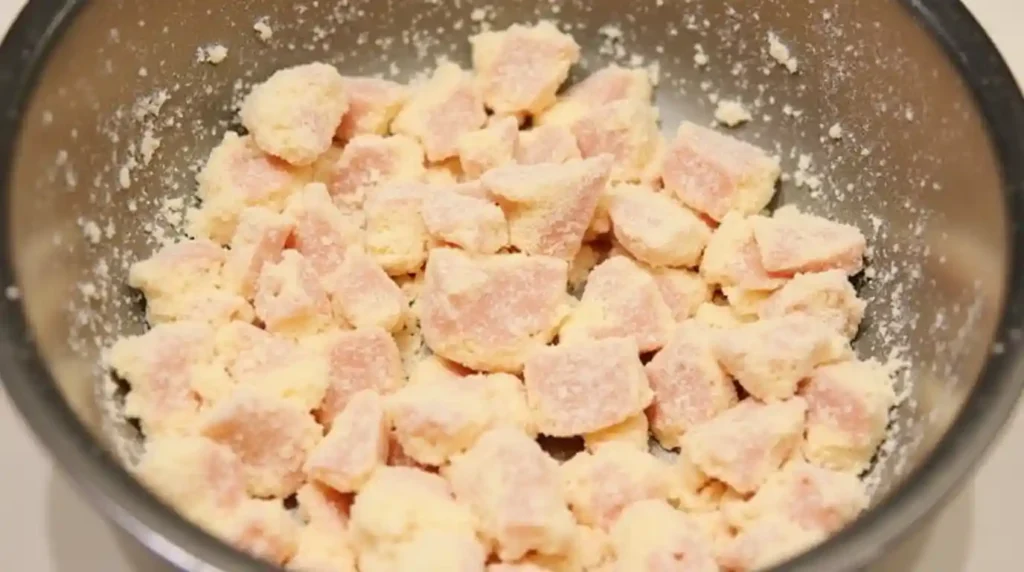
Step 2 – Whisk the sauce
In a separate mixing bowl, combine creamy peanut butter, soy sauce, hoisin sauce, minced garlic, grated ginger, rice vinegar, and a splash of water. Whisk until the mixture is smooth and velvety.
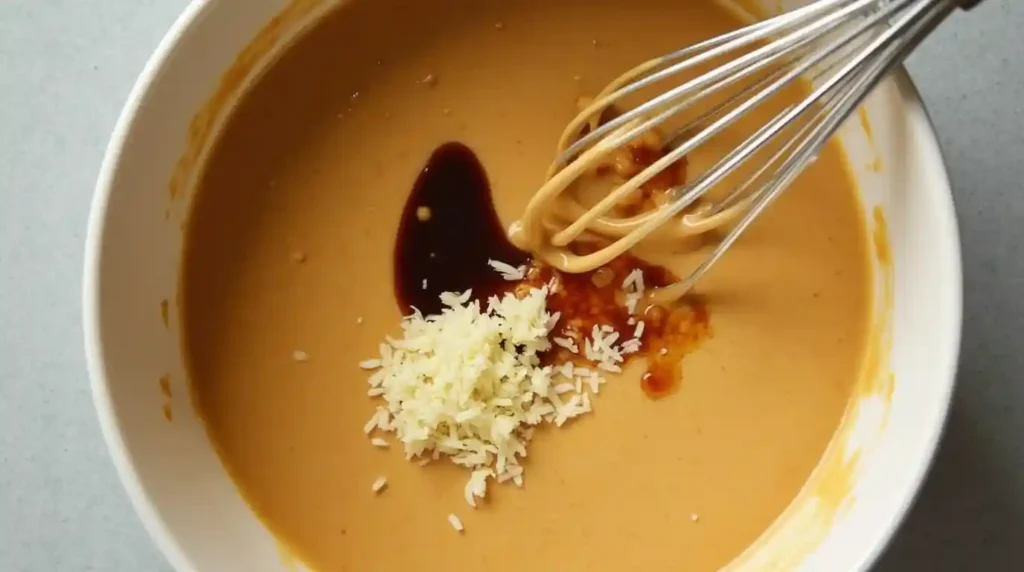
Step 3 – Sear the chicken
Heat a large skillet or wok over medium heat. Add a drizzle of vegetable oil and let it shimmer. Sear the chicken pieces until golden on all sides and cooked through, about 5–7 minutes. Remove the chicken and set it aside.

Step 4 – Cook the sauce
In the same skillet, pour the peanut butter mixture and stir over low heat. Let it simmer gently, allowing the flavors to meld and the sauce to thicken slightly.
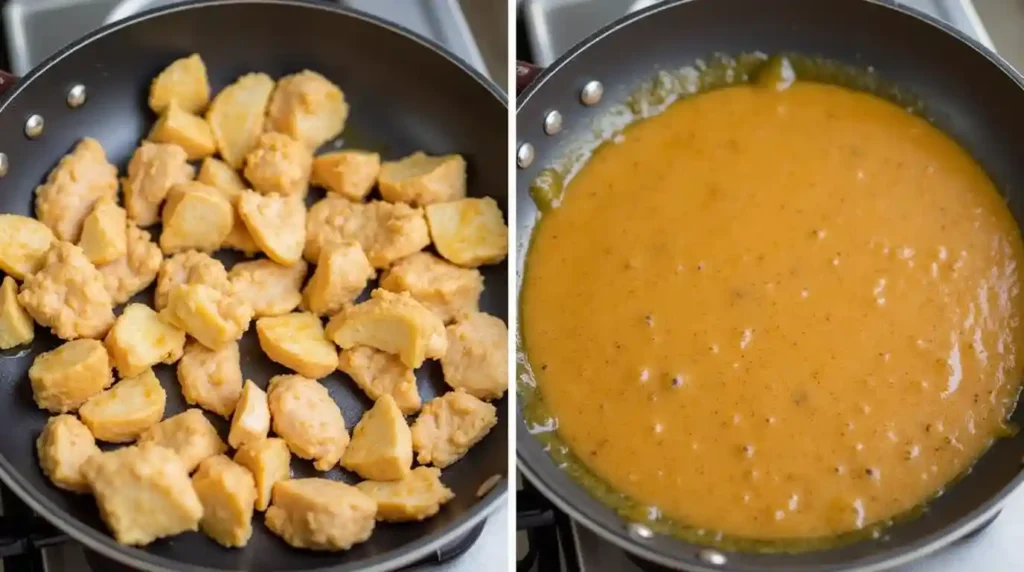
Step 5 – Combine and finish
Return the cooked chicken to the skillet, tossing it in the sauce until every piece is generously coated. Simmer for 2–3 minutes for the chicken to absorb the flavors.
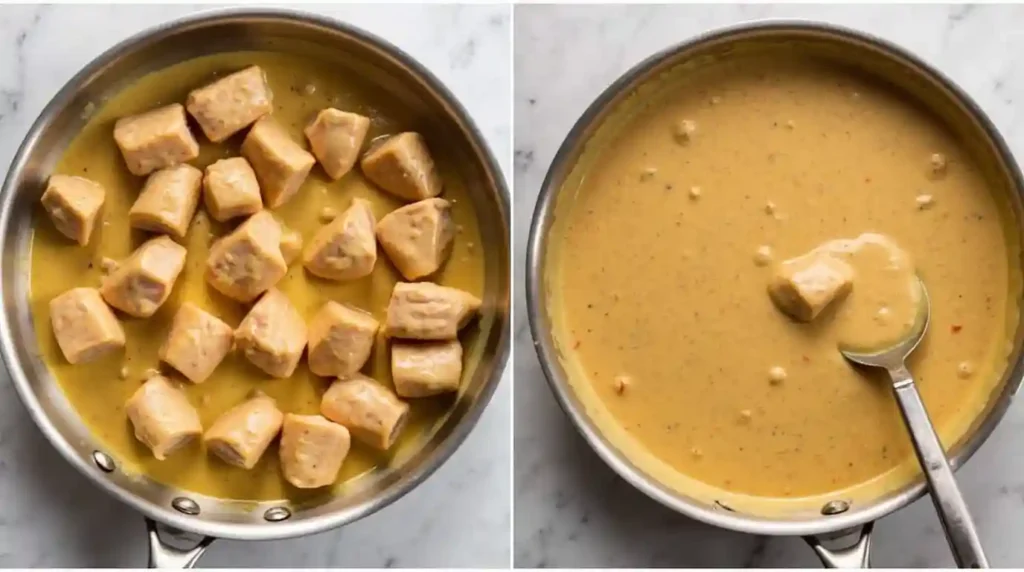
Step 6 – Serve and enjoy
Plate the chicken with peanut butte over steamed rice or noodles, and garnish with chopped scallions or crushed peanuts for added texture and freshness.
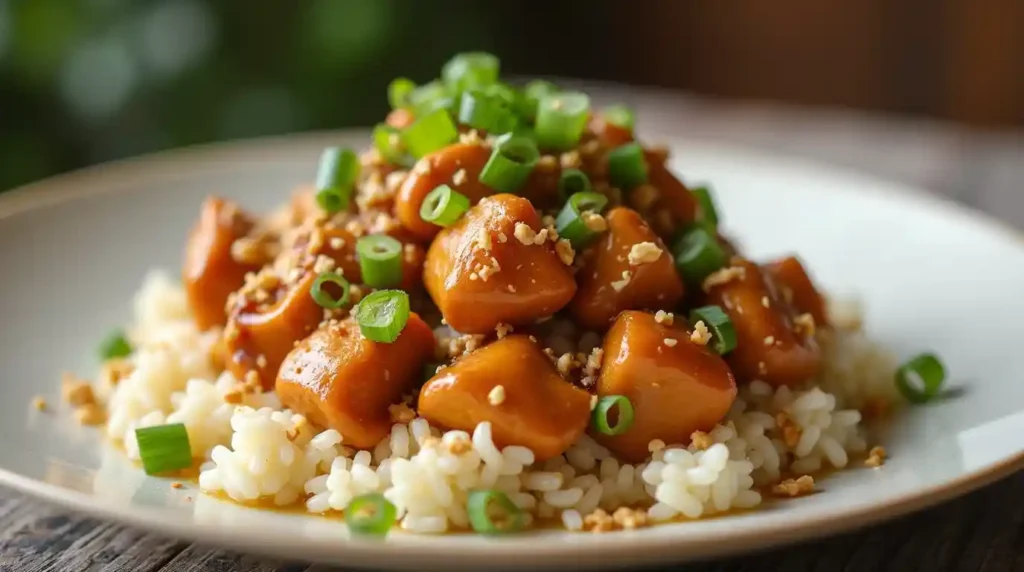
Arman’s recipe tips and variations
Use high-quality peanut butter
Opt for a smooth and natural peanut butter for the best flavor. Avoid varieties with added sugar or oils to keep the peanut butter chicken balanced and rich.
Cut chicken evenly
Ensure the chicken pieces are uniform in size. This helps them cook evenly and absorb the sauce properly, enhancing the dish’s texture and taste.
Add a touch of spice
Incorporate chili paste or red pepper flakes if you prefer a spicy twist to your peanut butter chicken. Adjust the heat level to suit your preference.
Experiment with vegetables
Boost the nutritional value by adding bell peppers, snap peas, or carrots. Stir-fry them alongside the chicken for added color and crunch.
Swap for alternative proteins
For a different take, replace chicken with tofu, shrimp, or even beef. These variations work seamlessly with the creamy peanut butter sauce.
Choose your base wisely
Pair the dish with jasmine rice, cauliflower rice, or even flatbread. Each option brings a unique element to the peanut butter chicken experience.
Garnish with flair
Top the dish with crushed peanuts, sesame seeds, or freshly chopped cilantro for added flavor and visual appeal.
Make it gluten-free
Substitute soy sauce with tamari or coconut aminos to create a gluten-free version without compromising taste.
Storage instructions
To store: Allow the peanut butter chicken to cool completely. Transfer it to an airtight container and refrigerate for up to four days.
To freeze: Place the cooled peanut butter chicken in a freezer-safe container or heavy-duty zip-top bag. Label it with the date and freeze for up to three months.
Reheating: For best results, reheat on the stovetop over medium-low heat. Add a splash of water or broth to loosen the sauce as it warms. Stir occasionally until heated through.
Microwave option: Transfer a portion of the peanut butter chicken to a microwave-safe dish. Cover loosely and heat in 30-second increments, stirring between intervals, until warmed evenly.
Freezing tips: If freezing, portion the chicken and sauce into individual servings. This allows you to thaw only what you need, minimizing waste and preserving freshness.
Avoid: Repeatedly freezing and thawing the dish, as this can affect the texture of the chicken and the consistency of the sauce.
Garnish fresh: When reheating, add fresh toppings like chopped peanuts or cilantro after warming to maintain their crunch and vibrant flavor.
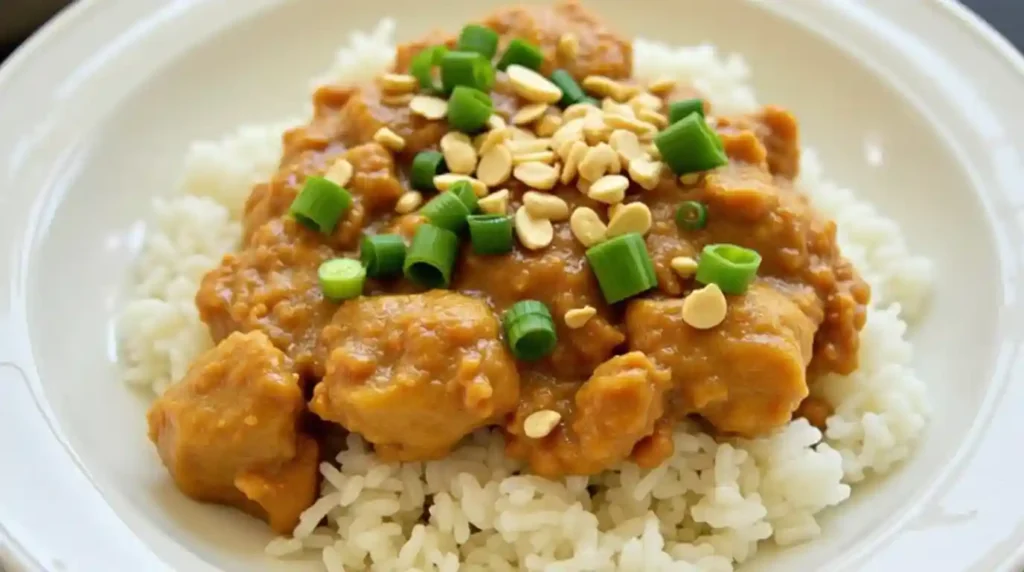
Cooking tools and equipment for perfect results
Sharp knife and cutting board
A high-quality sharp knife ensures clean, even cuts for your chicken, which is crucial for consistent cooking in your peanut butter chicken dish. A sturdy cutting board provides a stable surface for safe preparation.
Large non-stick skillet or wok
A non-stick skillet or wok is ideal for searing the chicken and simmering the sauce. The wide surface allows for even heat distribution and prevents the sauce from sticking or burning.
Heat-resistant spatula
Use a heat-resistant spatula to stir and toss the ingredients without scratching the skillet. It’s essential for evenly coating the chicken in the rich peanut butter sauce.
Measuring cups and spoons
Precision is key when preparing the sauce. Measuring tools help ensure the perfect balance of flavors in your peanut butter chicken.
Mixing bowls
Separate mixing bowls are useful for marinating the chicken and whisking the sauce ingredients. Choose bowls with sturdy bases to avoid spills.
Tongs
Tongs make it easy to handle the chicken while searing, ensuring even browning without breaking the pieces.
Ladle or serving spoon
A ladle is perfect for pouring the creamy sauce over the chicken before serving, ensuring every bite is drenched in flavor.
More Asian take-out style chicken recipes
If you’re a fan of peanut butter chicken, there are plenty of other Asian-inspired chicken dishes that will satisfy your cravings for bold, savory flavors.
General Tso’s Chicken
This dish features crispy fried chicken pieces tossed in a sweet, tangy, and slightly spicy sauce. It’s a great alternative to peanut butter chicken when you’re in the mood for something with a kick.
Orange Chicken
Tangy and sweet, orange chicken is coated in a glossy sauce made with fresh orange juice, soy sauce, and a touch of sugar. It pairs wonderfully with steamed rice, just like peanut butter chicken.
Teriyaki Chicken
A classic choice, teriyaki chicken is marinated in a soy-based sauce with ginger, garlic, and a hint of sweetness. It’s an easy and flavorful option that delivers that savory-sweet profile you love in peanut butter chicken.
Kung Pao Chicken
This dish is perfect for those who enjoy a bit of heat. Stir-fried chicken is combined with peanuts, vegetables, and a savory sauce with a spicy kick. The crunchy peanuts make it a great match for fans of peanut butter chicken.
Thai Basil Chicken
For a lighter, herb-infused take, Thai basil chicken is cooked with fragrant basil, garlic, and chilies. The fresh flavors contrast beautifully with the richness of dishes like peanut butter chicken.
The history of peanut butter in savory dishes
Peanut butter, often associated with sweet spreads and desserts, has a surprisingly rich history in savory dishes, particularly in Asian cuisines. The inclusion of peanut butter chicken is part of a broader tradition where peanuts are used to add depth, texture, and flavor to sauces and stews.
The origins of using peanuts in savory dishes can be traced back to African and South American culinary practices, where ground peanuts were used to thicken stews and enhance flavors. It wasn’t until the 20th century that peanut butter began to find its place in mainstream savory cooking, particularly through the influence of Asian cooking.
In countries like Thailand, China, and Indonesia, peanuts have long been a staple in savory sauces. The creamy, nutty texture of peanut butter complements the bold, salty, and spicy notes common in Asian stir-fries and marinades. Peanut butter chicken, for example, combines the creamy richness of peanut butter with the savory depth of soy sauce and garlic, creating a harmonious balance.
As global cuisine became more interconnected, peanut butter’s versatility in savory dishes gained popularity worldwide. Today, peanut butter chicken is a beloved dish, representing the fusion of traditional flavors with modern culinary creativity.
How to pair peanut butter chicken with sides
When it comes to pairing sides with peanut butter chicken, the goal is to complement its rich, creamy texture without overpowering its bold flavors. Start by balancing the savory and sweet notes of the dish with fresh, light sides.
Steamed Jasmine Rice
A classic choice, jasmine rice provides a fragrant base that absorbs the savory peanut sauce beautifully. Its delicate aroma enhances the peanut butter chicken, allowing the dish’s richness to shine without clashing.
Vegetable Stir-Fry
For a burst of color and crunch, serve your peanut butter chicken alongside a vegetable stir-fry. Broccoli, bell peppers, snap peas, and carrots add freshness and texture, balancing the creamy sauce with their crispness.
Cucumber Salad
A refreshing cucumber salad with a tangy vinaigrette adds brightness to the meal. The coolness of the cucumbers contrasts with the warm, hearty peanut butter chicken, creating a perfect harmony of flavors.
Cauliflower Rice
For a low-carb option, cauliflower rice is a wonderful alternative. It’s light and neutral, allowing the flavor of the peanut butter chicken to remain the star of the meal.
Asian Noodles
If you’re in the mood for something more substantial, serve your peanut butter chicken with Asian-style noodles. Their slight chewiness pairs wonderfully with the creamy sauce.
Health benefits of peanut butter and chicken combination
The combination of peanut butter chicken offers a balanced nutritional profile, bringing together the health benefits of lean protein and heart-healthy fats.
Protein Boost from Chicken
Chicken, particularly lean cuts like chicken breasts, is an excellent source of high-quality protein. Protein is essential for muscle repair, immune function, and overall growth. When paired with peanut butter chicken, this combination can help meet daily protein requirements in a flavorful way.
Healthy Fats from Peanut Butter
Peanut butter is rich in monounsaturated fats, which promote heart health by lowering bad cholesterol levels. These healthy fats are crucial for maintaining a healthy cardiovascular system. Additionally, peanuts are a good source of vitamin E, which is an antioxidant that helps protect cells from oxidative damage.
Fiber and Micronutrients
Peanuts provide a good amount of fiber, which supports digestive health. They also contain essential vitamins and minerals, such as magnesium and potassium, which contribute to muscle function and fluid balance. When paired with the vitamins found in chicken, peanut butter chicken becomes a nutrient-dense meal.
| Nutrient | Chicken | Peanut Butter |
|---|---|---|
| Protein | High | Moderate |
| Healthy Fats | Low | High |
| Fiber | Low | Moderate |
| Vitamins | B6, Niacin | Vitamin E, Magnesium |
Together, these ingredients create a well-rounded, health-conscious meal that satisfies and nourishes the body.
Cooking tools and equipment for perfect results
To make peanut butter chicken with flawless results, having the right tools in the kitchen is essential.
Sharp Chef’s Knife
A sharp chef’s knife allows you to cut the chicken into uniform pieces, ensuring even cooking. Precision in preparation sets the stage for a perfectly cooked dish.
Non-Stick Skillet or Wok
For searing the chicken and cooking the sauce, a large non-stick skillet or wok is indispensable. It provides even heat distribution, preventing the sauce from sticking while ensuring the chicken cooks evenly. A wok, in particular, excels in allowing you to stir-fry ingredients at high heat.
Heat-Resistant Spatula
A heat-resistant spatula is crucial for flipping and stirring the chicken without damaging the non-stick surface of your pan. It also helps coat the chicken evenly with the creamy peanut butter sauce.
Measuring Cups and Spoons
Accurate measurements are vital when preparing the sauce for peanut butter chicken. Measuring cups and spoons ensure you get the perfect balance of flavors, such as the right amount of peanut butter, soy sauce, and spices.
Mixing Bowls
A set of sturdy mixing bowls helps in preparing the marinade for the chicken and combining the sauce ingredients before cooking. A good-quality bowl ensures no spills during mixing.
With these tools, you can elevate the flavor and texture of peanut butter chicken, making your cooking experience seamless and enjoyable.
Frequently Asked Questions
Can we eat chicken and peanut butter together?
Yes, chicken with peanut butter creates a unique and harmonious blend of flavors. The creamy, nutty richness of peanut butter complements the savory taste of chicken, offering a deliciously balanced dish.
Can you cook with peanut butter?
Yes, peanut butter is a versatile ingredient that can be used in both sweet and savory dishes. It adds creaminess, depth, and a nutty flavor to various recipes. From sauces for stir-fries, like chicken with peanut butter, to smoothies, baked goods, and marinades, peanut butter enhances both texture and taste. When used in cooking, choose smooth peanut butter for a silky sauce or chunky peanut butter for added texture.
Can chickens eat peanut butter?
Chickens can eat peanut butter in moderation, but it should not be a regular part of their diet. Peanut butter is high in fat and salt, which could lead to obesity or health issues if given too frequently. If you do offer peanut butter to chickens, make sure it’s unsweetened and unsalted. A small amount spread on treats like whole-grain bread or as a topping for fruits and vegetables can be an occasional snack. Always ensure that the majority of their diet consists of appropriate poultry feed and fresh water.
How many calories are in peanut butter chicken?
The calorie content of peanut butter chicken can vary depending on the specific recipe and portion sizes. However, a typical serving of peanut butter chicken (approximately 1 cup) can contain between 400 to 600 calories. This estimate includes the chicken, peanut butter, and accompanying sauce.
The exact calorie count depends on factors like the amount of peanut butter used, the type of chicken (e.g., skinless chicken breast vs. thigh), and any additional ingredients (like oils or sugars). To reduce the calorie count, consider using less peanut butter, opting for low-fat chicken cuts, and minimizing added oils or sugary sauces. For an accurate estimate, it’s best to calculate based on the specific ingredients and quantities used in your recipe.
Is peanut butter high in calories?
Yes, peanut butter is relatively high in calories. A 2-tablespoon serving (about 32 grams) of peanut butter typically contains around 190–210 calories. This is primarily due to its high fat content, although most of the fats are healthy monounsaturated and polyunsaturated fats. While it’s nutrient-dense, offering protein, fiber, and essential vitamins like vitamin E and magnesium, its calorie density means that portion control is important, especially for those monitoring their calorie intake.
Is butter chicken calorie heavy?
Yes, butter chicken can be calorie-heavy, especially when served with rich sauces and paired with sides like naan or rice. A typical serving of butter chicken (about 1 cup) can contain anywhere from 400 to 600 calories or more, depending on the recipe. The high calorie content primarily comes from the combination of butter, cream, and oil used to make the sauce, as well as the chicken itself. To make butter chicken a bit lighter, you can reduce the amount of butter and cream, or use lower-fat substitutes while maintaining the dish’s flavor.
When not to eat peanut butter?
There are a few situations when you might want to avoid eating peanut butter:
Allergies: If you have a peanut allergy, peanut butter should be completely avoided as it can trigger severe allergic reactions.
High-Calorie Diets: If you’re on a calorie-restricted diet or trying to lose weight, peanut butter should be consumed in moderation due to its high-calorie and fat content.
Blood Sugar Concerns: While peanut butter has a low glycemic index, it still contains fat and calories that could impact blood sugar levels, especially if consumed in large amounts. People with diabetes should monitor portion sizes.
Sodium Sensitivity: Some peanut butters contain added salt. If you’re watching your sodium intake due to high blood pressure or kidney conditions, opt for unsalted varieties or avoid it entirely.
Processed Peanut Butter: If you’re trying to avoid added sugars, preservatives, or unhealthy oils, avoid processed peanut butter that may contain these additives. Always choose natural peanut butter with minimal ingredients.
In general, it’s essential to be mindful of portion sizes and specific dietary needs when including peanut butter in your meals.
Is Egg good with peanut butter?
Eggs and peanut butter can be a surprisingly good combination, offering both protein and healthy fats in one meal. When paired together, they create a balanced dish that provides energy, supports muscle repair, and offers a satisfying texture.
You can combine them in various ways. For example, a peanut butter spread on scrambled eggs or a peanut butter omelette can be an unconventional but delicious twist. The creamy, nutty flavor of peanut butter complements the savory richness of eggs.
However, if you’re watching your calorie intake or fat consumption, it’s important to use peanut butter in moderation, as it is calorie-dense. Additionally, opt for natural peanut butter without added sugars or unhealthy oils to keep the combination as healthy as possible.
If you enjoy experimenting with flavors, eggs and peanut butter can make for a unique and nourishing meal!
Is it OK to eat butter chicken?
Yes, it is generally okay to eat butter chicken, especially when enjoyed in moderation as part of a balanced diet. Butter chicken is a flavorful and popular dish, but it is often rich in calories, fat, and sodium due to the use of butter, cream, and oil in the sauce. If you’re mindful of your portion sizes and occasionally enjoy the dish as a treat, it can be part of a healthy diet.
If you have specific health concerns like high cholesterol, high blood pressure, or are trying to manage your weight, consider lighter variations of butter chicken by using less butter or cream, or substituting healthier ingredients like Greek yogurt or coconut milk. You can also pair butter chicken with vegetables or whole grains to increase its nutritional value and balance out the richness of the dish.
As with any indulgent dish, the key is moderation and balancing it with other nutrient-rich foods.
(Recipe Card) Peanut Butter Chicken Recipe
peanut butter chicken
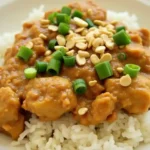
Peanut Butter Chicken is a flavorful and creamy dish that combines chicken with a rich peanut butter sauce. It’s a satisfying blend of savory, sweet, and nutty flavors, often served with rice or vegetables. The recipe is quick to prepare and can be easily customized to suit your taste preferences.
- 1 lb (boneless, skinless, cut into bite-sized pieces) Chicken Breast
- 1/2 cup (smooth, unsweetened) Peanut Butter
- 3 cloves (minced) Garlic
- 1 tsp (grated) Ginger
- 1 cup (or alternative milk) Coconut Milk
- 1 tbsp (optional, for sweetness) Honey
- 1/2 cup (to thin the sauce) Water
- 1 tbsp (optional, to thicken sauce) Cornstarch
- 2 tbsp (for cooking)Olive Oil
- 3 tsp Soy Sauce
- 2 tbsp Sesame Oil
Prepare the chicken: Season the chicken pieces and set them aside.
Make the peanut butter sauce: Whisk together peanut butter, soy sauce, garlic, ginger, sesame oil, coconut milk, hoisin sauce, and honey in a bowl.
Cook the chicken: Heat oil in a pan, add the chicken, and cook for 5-7 minutes until browned and cooked through.
Combine: Pour the peanut butter sauce over the chicken, stir to coat, and let it simmer for 5-10 minutes until thickened.
Serve: Garnish with green onions or peanuts if desired, and serve over rice or vegetables.
- Customizations: Add chili flakes for spice or substitute peanut butter with almond butter for a different flavor profile.
- Storage: Store leftovers in an airtight container in the fridge for up to 4 days. Reheat in the microwave or on the stove.
- Serving Suggestions: Pair with steamed rice, cauliflower rice, or sautéed vegetables for a complete meal.
In conclusion, peanut butter chicken is a unique and delicious dish that combines the savory flavors of chicken with the creamy richness of peanut butter. It’s a versatile recipe that can be customized with different ingredients and served alongside various sides to suit your taste. Whether you’re looking for a quick weeknight dinner or a flavorful twist on traditional chicken recipes, this dish is sure to satisfy.
For more delicious breakfast ideas, check out this pancake breakfast recipe. If you’re interested in more cooking inspiration, you can visit the Enjoy By Recipes YouTube channel for video tutorials and more helpful tips. Happy cooking!
